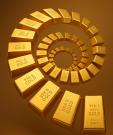Gold Forecast: What Now For Future Gold Price?

Gold showed what it can do last week - by rising 5% during the period of uncertainty around the US Presidential election.
In a classic, almost textbook, move, gold rose while the stock market and other indices and currencies fell - shown here by the long red arrows on this chart. The S&P 500 is on top and gold below.

Nothing shows the resilience and reliability of precious metals, and their ability to preserve value, more than a full-blown crisis of confidence. Panic is even better at revealing this!
Gold prices have since fallen back 9%. Consequently, it is presenting yet another great buying opportunity before the next rise.
We are going have a quick look at the factors affecting the gold price and try to determine where gold might go.
The first factor in any price analysis must cover supply and demand. Gold is traded and kept both privately and by government. It is sold and priced in an open market.
Gold Has Its Uses
Demand for private use is divided into investment and non-investment purposes.
“Investment” covers coins, bullion, bars, ingots - but also EFTs and other “paper” assets based on the gold price.
Estimates put between a half and two-thirds of all annual production is earmarked for private use.
The “non-investment” sector can be split into other areas. One is the “depletive” use of gold for dentistry, manufacturing and other industrial use.
These commercial needs take roughly 15% of annual production. Gold here is no longer in circulation or easily recoverable - so this needs replacing.
“Non-depletive” uses are for jewelry, bullion and general hoarding.
Remaining manufacturing capacity is thought to be for “off-market” use and government stockpiling as “strategic assets.” This is an area where secrecy is paramount and this makes assessment difficult.
Producing The Goods
In terms of production, around 3,000 metric tons of gold was freshly mined in 2015. Of this, China consumed 984.5 tons - almost a third of total production. India was next with 848.9 - not far behind. Gold demand always rises in annual gift seasons such as Chinese New Year and Diwali in India.
Mined production, recycled production, and monetary sector sales are the three means by which gold comes to the market. Mines account for 60% of the production and recycled gold generation is at a 4 year high.
The United States was the third largest consumer with 192.8 metric tons - and Germany the fourth with 123.8 tons.
To put all of this into perspective, in 2014 the total amount of gold holdings allocated to Individual Retirement Accounts (IRAs) was 61.8 tons.
This balancing act between supply and demand leads to market price fluctuations, some of which are recurring and known about, and others which are more unusual.
The next big factor is inflation. Here countries print money to repay debts and each extra banknote put into circulation reduces the “real” amount the banknote is worth.
Banknotes, or currency, as it is known, has no inherent value of its own - just a piece of paper with a promise to pay. Gold is bought and sold at a profit or a loss with currency - the price paid depending on the cycle of inflation.
Notably, inflation has been low in the major gold trading countries.
Disrupting The Status Quo
The third and main disrupter of the gold price this year has been the geopolitical risk. Syria, and the appalling situation there, threatens to destabilize the Middle-East.
A serious weakening of sterling has resulted from the Brexit vote in the UK - this is still ongoing.
The US Presidential election brought its own uncertainty - with Trump’s policies being unclear and Clinton’s possible future litigation under the spotlight.
Couple these events with general apprehension, and India's sinking consumer demand for gold - down 7% to a 7-year low of 441 tons due to government regulation, near record prices, and fragile rural sentiment - and you have a volatile cocktail of factors which affect the markets.
India, the second biggest consumer of gold, has also just withdrawn its higher denomination banknotes from circulation, without notice. This caused more uncertainty and panic as people realize the risk involved in holding currencies and consequently consider a possible flight to gold.
Our view is the gold price will now continue to rise. The Trump election effect has reminded people how quickly markets can move. Learn more about protecting your portfolio from market changes by downloading our FREE eBook, 7 Tips for Surviving a Wall Street Collapse.

















